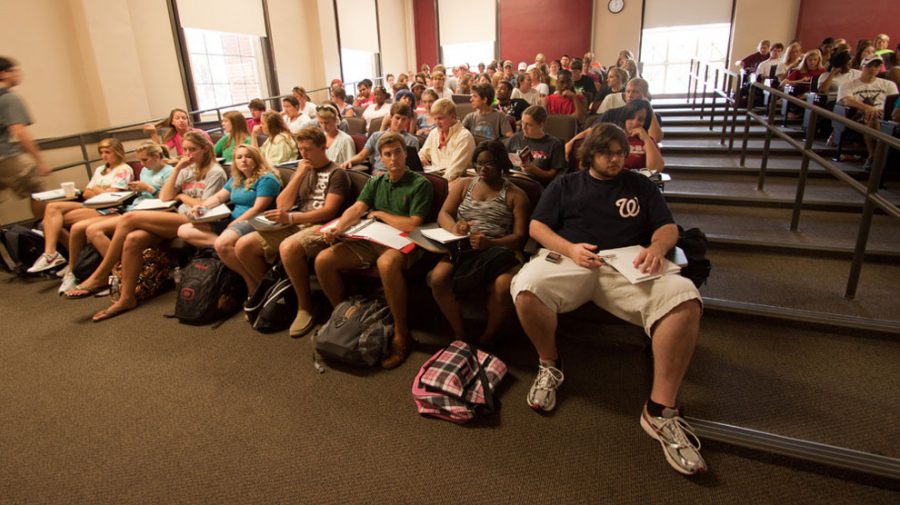As the campus grows to 31,747 students, faculty and students alike have noticed an increase in class size to accommodate the escalating numbers. Overcrowding and uncomfortable conditions in the classroom have become common complaints from students.
“It’s hard not to notice how crowded classes are,” said Susanne Treece, a sophomore majoring in English. “Every student is sitting directly beside another student. Everyone is tightly packed into the classroom.”
During the first week of the semester, classroom overcrowding was a larger problem due to miscommunication issues between faculty members.
“Some overrides were given by well-intentioned staff who thought that the capacity for the classrooms had not been reached when in fact it had,” said University Registrar Michael George. “In each case, the classroom capacity was exceeded by mistake. These problems were resolved expeditiously either by moving the classes to larger classrooms or asking students to move to a different section that still had seats available.”
However, even though the student body has increased drastically, the student-to-teacher ratio in 2006 of 19:1 was the same five years later in 2010. Due to good planning and execution, the University has been able to maintain the relatively low classroom ratio, said Judy Bonner, executive vice president and provost.
“As part of our plan to accommodate the larger student body, we had the capacity to grow without the addition of any new classrooms by simply improving our classroom utilization,” Bonner said.
Since this situational accommodation, smaller classes seem to fell the burden and uncomfortable atmosphere of overcrowding more directly than larger classes. Smaller classes must find the space and seating to serve their students.
“Some classes contain a random assortment of seating arrangements to fit the number of students,” Treece said. “Many times classes feel claustrophobic and tend to create an awkward proximity between students.”
By contrast, some professors have noticed that, although the student population at has increased, their classrooms are less crowded due to departmental maneuvering.
“Class enrollment has indeed increased over the past several years, commensurate with the student growth at UA,” biology professor Kim Caldwell said. “However, to accommodate for this, the Department of Biological Sciences now offers more sections of each class so that all students who want to take the course have an experience that is not overcrowded in our auditorium. In general, our department has opened more sections of several of our core curriculum courses to accommodate student growth.”
Unfortunately, some professors notice that overcrowding is not an important issue because of a decrease in student involvement throughout the year. Anthropology professor Elizabeth Cooper said she believes her classroom might feel uncomfortable if students attended class regularly.
“If students were as enthusiastic about class attendance as they were at the beginning of the semester, overcrowding may be more of a problem in my class than it is in reality,” Cooper said.
If students are still uncomfortable with the crowding of classrooms, office associate for the Honors College Yolanda Williams reminds students that with an average student-to-teacher ratio of 15:1, the Honors College is a great way to avoid the stresses that overcrowding can cause.
“In the Honors College, classes tend to be much smaller compared to their non-Honors equivalents,” Williams said. “We offer students a more individual approach to learning that is hard to find in other classes.”









